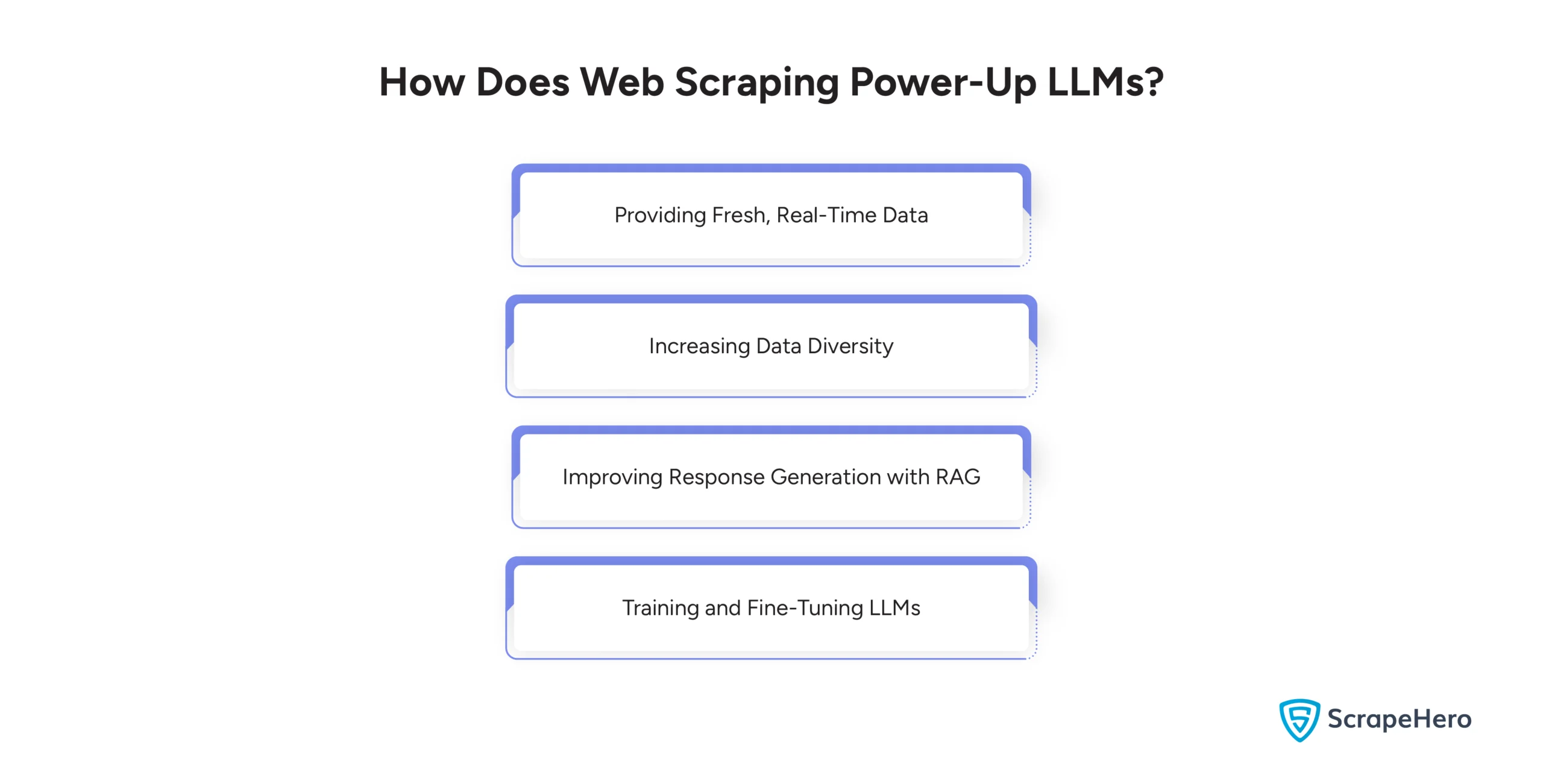By integrating web scraping with LLMs and Retrieval-Augmented Generation (RAG), you can boost real-time data accuracy by over 50%.
To find out how web scraping and RAG can supercharge LLMs, continue reading the article.
What Are LLMs and Why Do They Need Fresh Data?
Large Language Models (LLMs) are deep learning models developed and trained to understand and generate human language using vast amounts of text data. Models such as GPT-4 and BERT are examples of LLMs.
One major challenge is that these LLMs are trained on static datasets and become outdated if not trained with recent data trends or new technological advancements.
But with web scraping for LLMs, you can bridge the gap by providing up-to-date, real-time data, and RAG can make this data more accessible for generating accurate responses.
How Does Web Scraping Power-Up LLMs?
Web scraping extracts data from various websites and transforms raw, unstructured data into structured formats for analysis. Here’s how web scraping can enhance LLMs:
- Providing Fresh, Real-Time Data
- Increasing Data Diversity
- Improving Response Generation with RAG
- Training and Fine-Tuning LLMs
1. Providing Fresh, Real-Time Data
Web scraping is required to ensure that LLMs have access to the most recent information so that they can make their outputs more accurate.
2. Increasing Data Diversity
In web scraping, the data is extracted from a vast source and diverse fields, including technology and medicine.
This improves their contextual understanding and ability to handle different topics.
3. Improving Response Generation with RAG
Retrieval-Augmented Generation (RAG) is an AI framework that allows LLMs to retrieve real-time data.
Using scraped data, LLMs can significantly enhance their response accuracy.
4. Training and Fine-Tuning LLMs
Web scraping gathers high-quality data that can be used to fine-tune LLMs, improving their performance in specific domains.

What is RAG and How Does It Work with Web Scraping?
Retrieval-Augmented Generation (RAG) is an approach that integrates a retrieval mechanism along with LLM and enhances its capabilities.
Integrating web scraping into RAG pipelines allows for access to live data. During the generation process, RAG enables LLMs to access the most recent and relevant information.
Web scraping for RAG allows LLMs to pull real-time content from web sources. When domain-specific information is fed into RAG, LLMs provide more accurate and insightful responses.
For instance, a chatbot running on a RAG-powered LLM could scrape live stock prices or financial reports. Processing this real-time data could provide immediate and relevant investment advice.
How Enterprises Can Benefit from Combining Web Scraping with LLMs and RAG
Enterprises can combine web scraping with LLMs and RAG and can gain significant advantages, such as:
- Real-Time Data Access
- Enhanced Decision-Making
- Automated Data Collection and Analysis
- Increased Accuracy and Relevance in AI Models
- Better Customer Experience
- Competitor Analysis and Benchmarking
- Improved Content Generation
- Risk Management
1. Real-Time Data Access
Enterprises can gather up-to-date data from various sources using web scraping and then integrate this data in real-time, combining it with LLMs and RAG for better analysis and decision-making.
Real-time data access enables enterprises to react faster to market shifts, competitor strategies, or customer behavior changes, and most importantly, putting them firmly in control of their business dynamics.
2. Enhanced Decision-Making
Businesses can make well-informed decisions based on the latest trends, as LLMs with real-time scraped data provide better forecasting models.
Using LLMs enhanced with RAG, enterprises can analyze real-time customer feedback and reviews, which can lead to product improvements.
3. Automated Data Collection and Analysis
Web scraping can automate large-scale data, and LLMs process and analyze this data quickly, saving time.
This allows enterprises to streamline workflows, reduce overhead costs, and improve operational efficiency.
4. Increased Accuracy and Relevance in AI Models
LLMs can generate more accurate and contextually relevant insights using real-time scraped data, which improves the quality of outputs like product recommendations.
Even as external conditions change, these LLM models remain accurate and relevant when they are powered by RAG, quickly adapting to new data.
RAG plays a crucial role in this process by providing a mechanism for the models to update and adapt, ensuring their continued accuracy and relevance.
5. Better Customer Experience
Enterprises can use LLMs to scrape real-time customer reviews and feedback, which are then analyzed to understand customer sentiment.
Such analysis guides the tailoring of interactions, improving customer satisfaction. Also, businesses can respond more quickly to customer concerns and improve overall satisfaction.
6. Competitor Analysis and Benchmarking
Businesses can stay competitive by monitoring competitors’ pricing, feeding this data into LLMs for analysis, and adjusting their strategies.
Also, businesses can benchmark their performance against competitors using real-time data and various metrics.
7. Improved Content Generation
LLMs enhanced with real-time web scraping can generate more relevant content, such as reports or social media posts, based on the latest trends.
Enterprises can use this method to create summaries of large datasets and help teams act quickly on important information.
8. Risk Management
When combining web scraping with LLMs, businesses can monitor external factors like market risks or supply chain disruptions in real-time.
This real-time data access can also be used by enterprises to detect anomalies by comparing scraped data against expected trends.

How Is ScrapeHero Web Scraping Service a Solution?
Web scraping and RAG are essential for ensuring LLMs have access to the most relevant data and improving the quality and accuracy of their responses.
Organizations must recognize the need to enhance their AI capabilities. Investing in a robust data pipeline that can integrate web scraping with LLMs and RAG is a crucial step toward delivering more insightful results.
With the help of a fully managed web scraping service like ScrapeHero, businesses can avoid complex technicalities and streamline the data extraction process.
Frequently Asked Questions
No. LLMs cannot scrape data directly. They usually rely on web scraping to gather real-time data, which they later use to enhance their knowledge base.
Web scraping can extract relevant information from customer reviews, social media posts, or news articles. This information can then be used to enhance the knowledge base of LLMs and fine-tune the models, improving their accuracy.
High-quality and diverse data are needed to improve the performance of LLMs. Through web scraping, diverse datasets are collected, and then models are trained on this data to generate more accurate, contextually relevant responses.
There are many data sources for LLMs, such as websites, social media, news, and e-commerce platforms.
We can help with your data or automation needs
Turn the Internet into meaningful, structured and usable data








